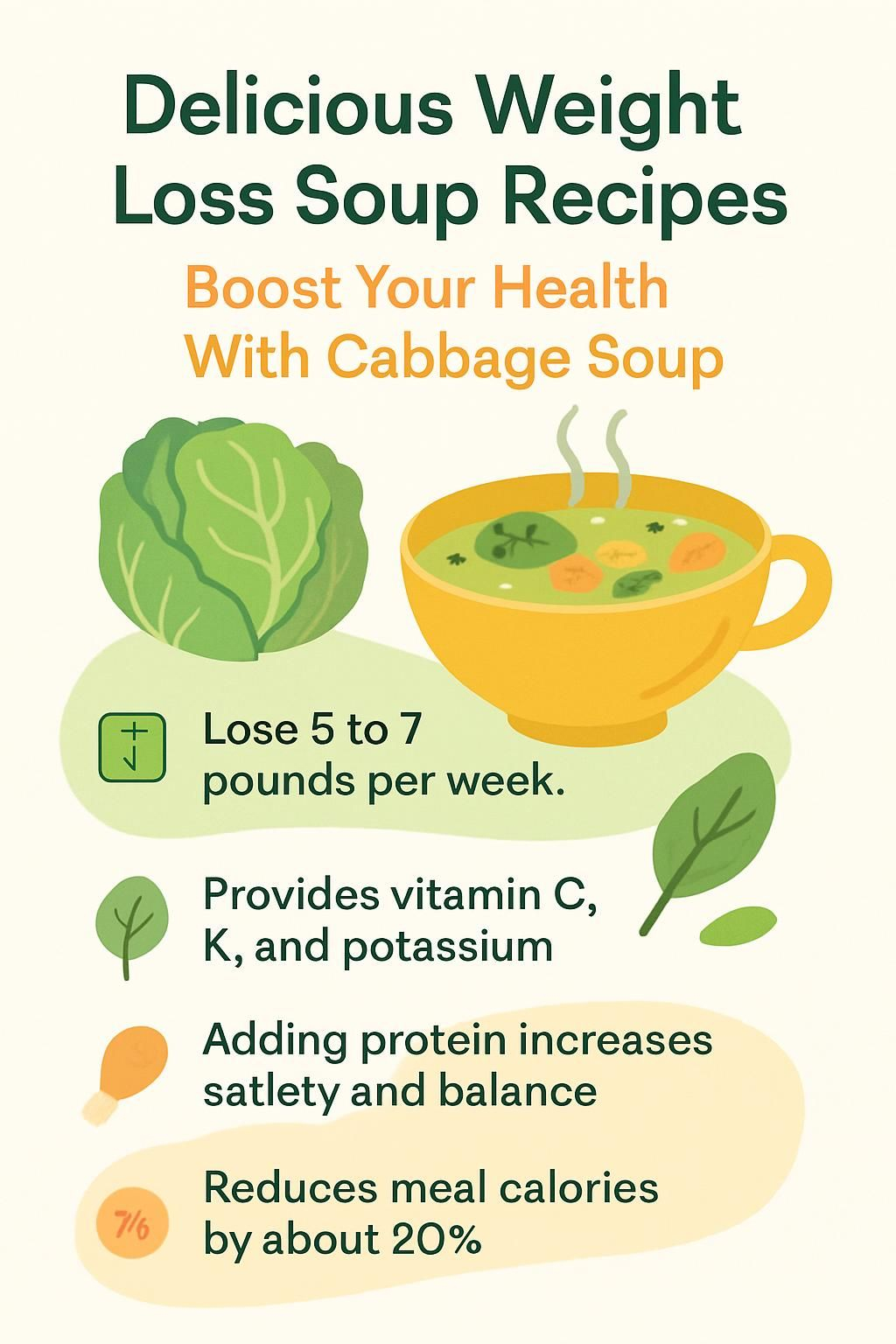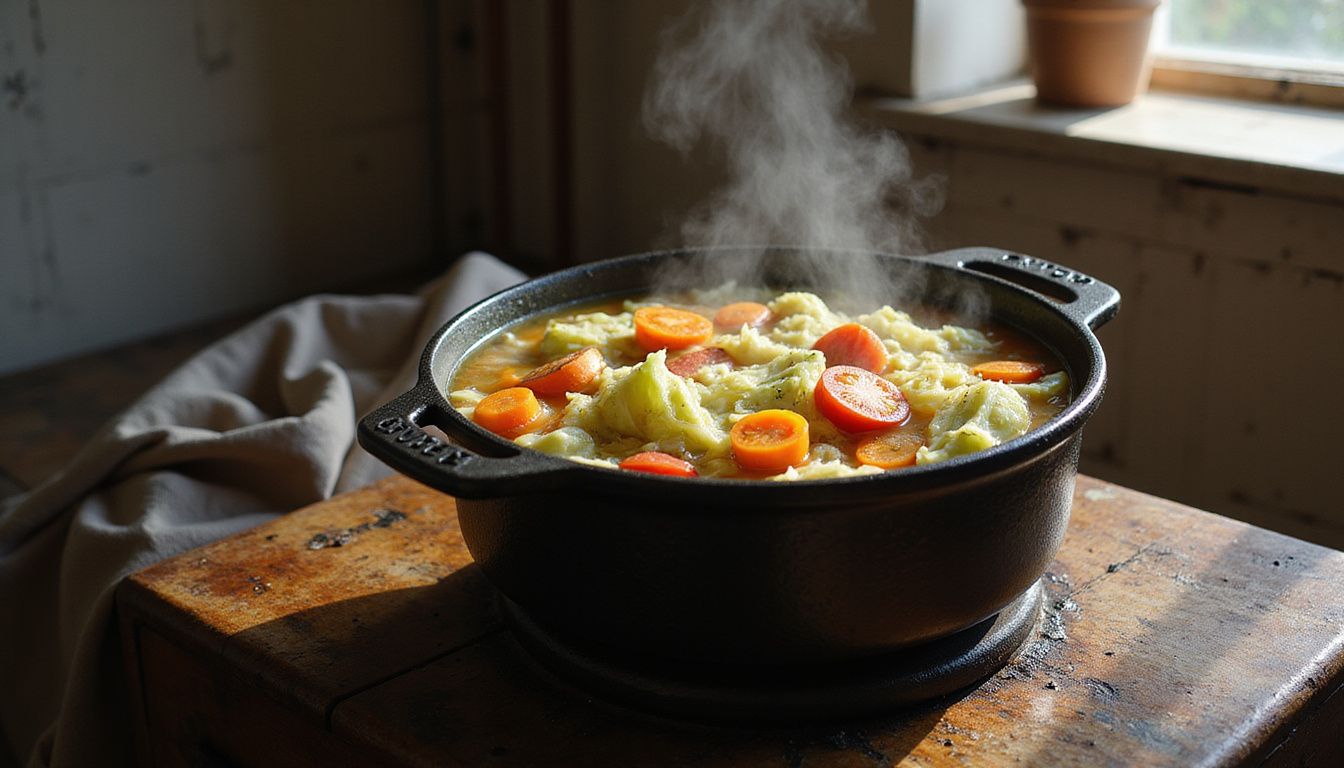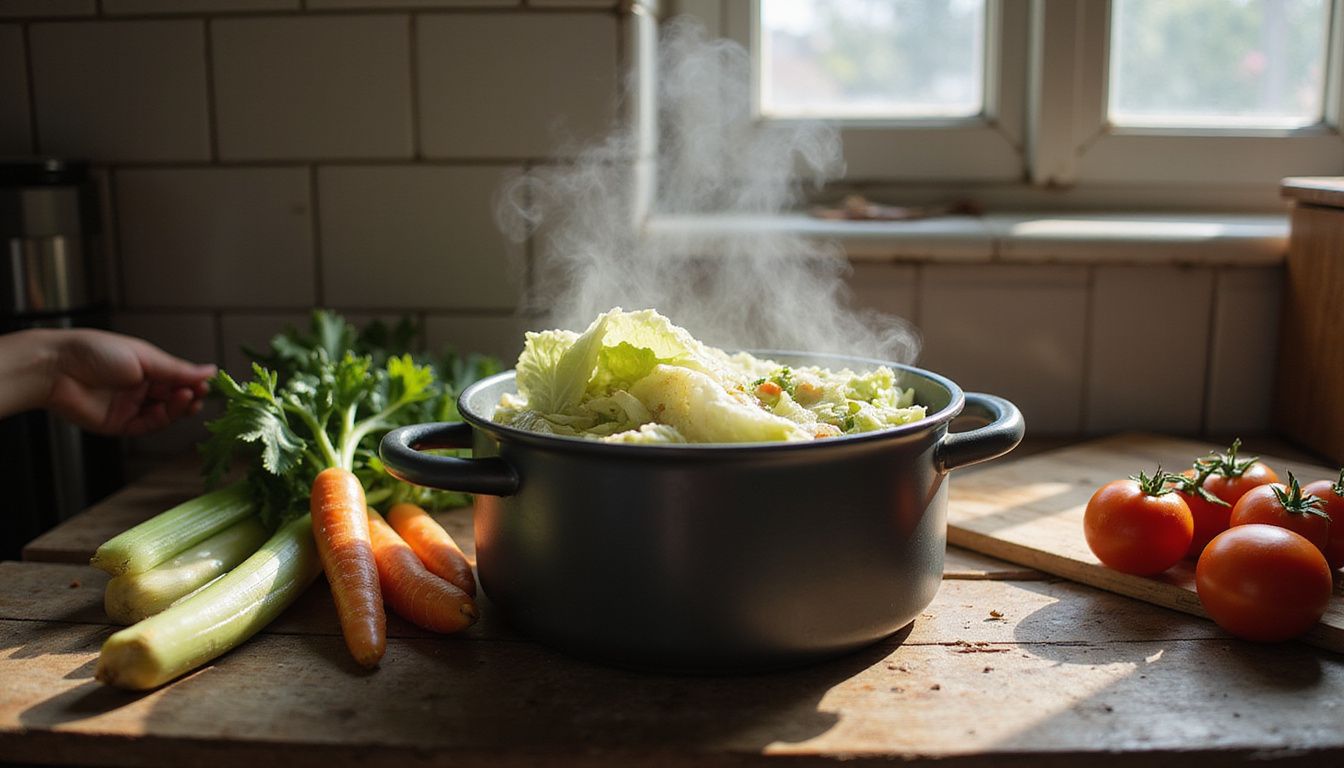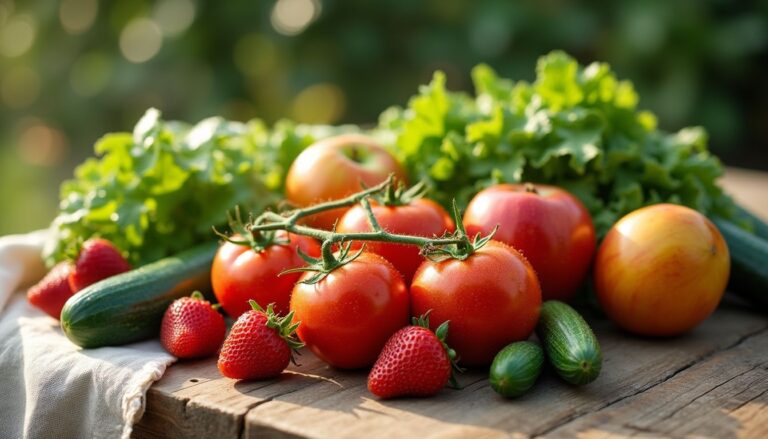Delicious Weight Loss Soup Recipes: Boost Your Health With Cabbage Soup
Our Nutrition Assistant AI Suite will transform your body. You will lose fat, get toned, and build muscle. Gain confidence and optimal health.
Trying to lose weight can feel hard, especially when meals leave you hungry. A simple weight loss soup like cabbage soup offers a warm, filling option that stays low in calories. Research suggests that people who include soup in meals often show lower Body Mass Index, or BMI, over time.
In this guide, you will learn how to make cabbage soup with common vegetables such as carrots, celery, tomatoes, and onions. You will also see smart ways to add lean protein and spice for better flavor and fullness.
Use these steps to enjoy a satisfying bowl that fits your diet plan without extra fat or sugar.
Key Takeaways
- Cabbage soup is low in calories and high in fiber, which can support short-term weight loss of about 5 to 7 pounds in a week, mostly water weight (Kelly RK et al., 2023).
- Each serving can deliver vitamin C, vitamin K, potassium, and antioxidants from tomatoes and bell peppers.
- Adding lean protein such as chicken or beans increases fullness, protects muscle, and supports balanced eating.
- Following a cabbage soup-only diet can miss key nutrients, including protein, healthy fats, B vitamins, iron, calcium, zinc, and magnesium.
- Starting meals with low-calorie soup may cut total meal calories by about 20 percent (Appetite, 2012).

Understanding Cabbage Soup

Think of cabbage soup as a light base you can build into a full meal. It is low in calories, high in water, and gives you fiber plus vitamins that support digestion and regularity.
What is the history of cabbage soup?
Cabbage soup grew from simple European home cooking that used cabbage, onions, and carrots. Families leaned on it during tough times because the ingredients were cheap and easy to find.
The cabbage soup diet became popular in the 1950s after magazines promoted quick-loss plans. Hospitals served similar light soups because they were filling yet low in calories. Health organizations, including Mayo Clinic, caution against single-food diets since they limit nutrients.
Modern versions include bell peppers, garlic, celery, tomatoes, and herbs. These add flavor and nutrition while keeping calories per serving low.
Why is cabbage soup popular for weight loss diets?
Many people choose cabbage soup because it is a low-calorie soup that helps curb hunger. The broth and fiber make you feel full faster, which can lower total calories at a meal.
Some try the 7-day cabbage soup diet for quick results. Weight changes often come from water loss in the first week. The recipe is affordable, easy to batch-cook, and uses everyday vegetables such as carrots, celery, tomatoes, and onions.
You can also adjust flavor with black pepper, garlic, or fresh herbs. This variety helps you stay on track without getting bored.
What are the health benefits of cabbage soup for dieting?
Weight-loss cabbage soup brings a mix of fiber and micronutrients that support weight control. The vegetables add vitamins, minerals, and water that help you feel satisfied on fewer calories.
How does cabbage soup’s calorie content and fiber help weight loss?
Cabbage soup stays light in calories but offers plenty of fiber. That mix lets you eat a full bowl and still keep energy intake low.
Research, including Kelly RK et al., 2023, links higher fiber diets with better satiety and lower calorie intake. Enjoying a cup of soup before the main course can reduce how much you eat later.
Most versions land under 100 calories per cup, depending on your soup ingredients. I often swap a sandwich for a big bowl at lunch. I stay satisfied longer without feeling weighed down.
What vitamins and minerals are in cabbage soup?
Cabbage soup supplies key nutrients that support immune health, bone health, and fluid balance. Here are a few examples:
- Vitamin C: about 36.6 mg per cup of chopped cabbage, which supports immunity.
- Vitamin K: about 76 mcg per cup of chopped cabbage, which supports normal blood clotting.
- Potassium: about 320 mg per cup of cooked carrots, which helps regulate fluid balance.
- Lycopene: an antioxidant in tomatoes that may help lower inflammation.
Each spoonful can move you closer to your Reference Daily Intake for key nutrients.
Choose low-sodium chicken broth to keep calories and salt in check. Season with carrots, bell peppers, garlic, onion, and black pepper. If using onion soup mix, look for a low-sodium option.
Does cabbage soup have detoxification properties?
Cabbage soup provides water and fiber, which help regular bowel movements. Good hydration supports your kidneys and liver, the organs that remove waste naturally.
No strong scientific evidence shows that a cabbage soup diet alone “detoxes” your body. Most detox claims lack research support. It is better to view the soup as a hydrating, low-calorie meal that supports your normal detox systems.
If you want a gentle reset, pair the soup with plenty of water, sleep, and balanced meals over several days.
Key ingredients in weight loss cabbage soup
These ingredients keep the soup light, flavorful, and filling. They also add color and nutrients that make each bowl feel complete.
Why is cabbage the main ingredient in this soup?
Cabbage is low in calories and high in water, so you get volume without many calories. One cup of chopped cabbage has about 22 calories and 2 grams of fiber.
It also gives you vitamin C for immune support and vitamin K for bones. The mild taste blends well with carrots, celery, tomatoes, and green beans. Cabbage holds its texture while simmering, which keeps each bite satisfying.
What role do bell peppers and tomatoes play?
Bell peppers add color, crunch, and a large dose of vitamin C. A single medium pepper can provide more than your daily need.
Tomatoes bring vitamin C and lycopene. Studies, such as Collins EJ et al., 2022, link tomato compounds with lower inflammation. Tomatoes also create a bright broth that ties the vegetables together.
How do onions and garlic enhance flavor?
Onions and garlic build a rich base. Sautéing them in a teaspoon of olive oil unlocks sweetness and aroma without many calories.
Garlic adds a savory note and may support immune function. Onions bring gentle sweetness that balances the acidity in tomatoes. You get bold taste without leaning on extra salt.
What nutrients do carrots and celery add?
Carrots deliver vitamin A for eye health, plus potassium and fiber. They also provide β-carotene, the orange pigment that acts as an antioxidant.
Celery is about 95 percent water, so it adds hydration and crunch with very few calories. Together, carrots and celery improve flavor and help you feel full longer.
Which herbs and spices improve the soup’s flavor?
Use black pepper, parsley, thyme, and chili flakes for bright flavor without extra calories. A tablespoon of chopped parsley has about 1 calorie but adds fresh aroma and color.
Chili flakes bring gentle heat that can increase enjoyment of each bowl. Cooks in many countries, including Italy, rely on herbs like these to make vegetable soups taste lively without extra salt.
How to make weight loss cabbage soup step-by-step
Prep the vegetables first, then build flavor in the pot. A few simple steps lead to a big pot you can enjoy for days.
How should you prepare the vegetables?
Rinse cabbage, carrots, celery, and other vegetables under cold running water. Peel firm vegetables like carrots or squash for a smooth texture.
Chop everything into even, bite-size pieces, about half-inch chunks. Even cuts help the soup cook evenly. Prepping ahead speeds up the cooking so textures stay consistent.
What are the cooking steps for the soup?
Start by sautéing chopped onions and minced garlic in a large pot until soft and fragrant. Add cabbage, tomatoes, celery, carrots, and bell peppers. Stir to coat the vegetables.
Pour in low-sodium broth or water until it just covers the vegetables. Bring to a boil over medium-high heat. Reduce to a simmer and cook for 25 to 30 minutes, until tender but still colorful.
Finish with parsley, thyme, black pepper, and chili flakes if you like heat. Taste and adjust seasoning before serving.
What protein additions can you include?
Stir in lean chicken or turkey after the vegetables are tender. Both add protein that supports fullness and muscle while you lose weight. Use cooked, bite-size pieces so they warm through quickly.
For a plant-based option, add beans or lentils near the end of cooking. One cup of beans or a half cup of cooked lentils boosts protein and fiber. Studies in the Journal of Nutrition, 2018, support the benefits of plant proteins for steady blood sugar.
How to customize your cabbage soup recipe
Small tweaks keep each pot fresh and interesting. Choose one change at a time, then note what you liked for next week.
What protein options work best: chicken or beans?
Skinless chicken breast offers about 26 grams of protein per 100 grams with little saturated fat. This suits a diet for weight loss that aims for higher protein and fewer calories.
Beans such as black beans, cannellini, or lentils supply protein and fiber together. One cup of cooked black beans has about 15 grams of protein and 15 grams of fiber. I like to combine diced chicken and white beans after workouts. The meal feels hearty and keeps me full.
How can you add heat with chili flakes or peppers?
Sprinkle chili flakes into the pot, or stir in a diced jalapeño for a gentle kick. Start with half a teaspoon of flakes or one small pepper per batch, then adjust to taste.
Capsaicin in chili peppers may slightly boost metabolism, according to NIH research from 2012. Most of all, spice can make low-calorie soup more exciting, which helps you stick with your plan.
Which other low-calorie vegetables can be included?
Great add-ins include spinach, zucchini, and cauliflower. Spinach wilts in at the end for vitamins A and K. Zucchini adds volume with very few calories.
Cauliflower brings extra fiber and vitamin C. Per cup, spinach has about 7 calories, zucchini about 19, and cauliflower about 25. These choices raise nutrient density without adding many calories.
What are the limitations of a cabbage soup-only diet?
A cabbage soup-only plan is very restrictive. It may cause short-term weight loss, yet it can also limit essential nutrients and lead to discomfort.
What nutritional deficiencies should be considered?
Protein and healthy fats may fall short, which can affect muscle repair and hormone balance. Skipping foods like beans, eggs, or fish makes it hard to meet daily amino acid needs.
Low variety can also reduce B vitamins, iron, calcium, zinc, and magnesium. Signs may include fatigue, hair loss, or slow wound healing. Citrus and fruit gaps can cut vitamin C intake, which weakens immune support.
To reduce risk, pair cabbage soup with protein, whole grains, fruit, vegetables, nuts, and seeds. If you have health conditions or take medication, talk with a registered dietitian or your clinician first.
Can cabbage soup cause digestive issues?
Large servings of high-fiber vegetables can cause gas, bloating, or cramps, especially if your usual fiber intake is low. Cabbage contains raffinose, a carbohydrate that can create extra gas for some people.
Increase portion size slowly and drink plenty of water. If symptoms continue, reduce the portion or eat the soup with a small protein side such as yogurt or eggs. Many people feel better after several days as the gut adjusts.
How to integrate cabbage soup into a balanced eating plan
Cabbage soup works best as part of a varied plan. Use it to cut calories at meals without feeling deprived.
How can you complement cabbage soup with nutritious meals?
Pair a bowl with lean protein such as grilled fish, baked poultry, tofu, or beans. Add whole grains like brown rice, quinoa, or whole-wheat bread for steady energy.
Eat a variety of fruits and vegetables during the day to cover vitamins and minerals. Rotating ingredients, like spinach, tomatoes, or legumes, helps fill common nutrient gaps.
When is it best to use cabbage soup as an appetizer or light meal?
Starting dinner with a low-calorie soup can lower total calories at that meal. A study in Appetite, 2012, found that people who began meals with soup ate about 20 percent fewer calories afterward.
Cabbage soup also makes a gentle evening meal. I sleep better on nights when I choose soup for dinner because I feel satisfied without feeling heavy. Light evening meals can also support digestion.
Keywords: Dish (food), Cucurbita
What is a simple weight loss cabbage soup recipe?
You need basic vegetables, broth, and a few herbs. The method is simple, and the result freezes well.
What ingredients are needed for this recipe?
Gather one medium head of cabbage, two onions, two bell peppers, three celery stalks, two carrots, and four large tomatoes. Chop them into bite-size pieces for even cooking.
Use six cups of low-sodium broth or water. Add parsley, black pepper, and chili flakes for heat if you like. For protein, include one cup of cooked diced chicken breast or one can of drained beans, such as cannellini or kidney beans. I have used chicken and white beans on busy days, and both made the soup more filling with little effort.
What are the detailed cooking steps?
1) Chop the vegetables. 2) In a large pot, sauté onions and garlic for 2 to 3 minutes until fragrant. 3) Add cabbage, peppers, carrots, celery, and tomatoes, then stir.
4) Pour in broth or water to cover. Bring to a boil over medium-high heat. 5) Reduce heat and simmer 25 to 30 minutes until tender. 6) Stir in parsley, thyme, and black pepper. Add cooked chicken or beans in the last few minutes to warm through. Taste and adjust seasoning.
What are the best tips for storing and preparing cabbage soup?
Good storage keeps flavor and texture. Smart reheating protects delicate vegetables from turning mushy.
How should you store cabbage soup for freshness?
Transfer cooled soup to airtight containers. Refrigerate at or below 40°F, 4°C, for up to 4 days.
For longer storage, freeze in labeled containers for up to 3 months. Dating each container helps you rotate safely during meal prep.
How can you preserve flavor when reheating soup?
Warm soup gently over low to medium heat, stirring every few minutes. This prevents scorching and keeps vegetables from breaking down.
Finish with chopped fresh herbs or a squeeze of lemon juice right before serving. I find this step brings back fresh flavor as if the pot just finished simmering.
Other nutritious weight loss soup options to try
Variety keeps your plan enjoyable. Rotating soups also spreads nutrients across the week.
What are the benefits of creamy carrot and cauliflower soup?
This soup is low in calories and high in fiber, which supports satiety. Carrots provide natural sweetness and vitamin A for eye health, while cauliflower adds vitamin C and more fiber.
The blended texture feels rich without cream. During busy weeks, this soup keeps me full and helps me skip extra snacks.
Why try hearty spicy black bean soup?
Black beans offer about 15 grams of protein and 15 grams of fiber per cooked cup. This pairing supports steady blood sugar and long-lasting fullness.
Chili spices add kick with minimal calories. You also get iron, magnesium, and potassium in every serving.
How flavorful is roasted butternut squash soup?
Roasting deepens the squash’s natural sweetness and adds caramel notes. The result tastes creamy even without heavy cream.
This soup provides vitamin A, potassium, and fiber that can help curb cravings. A pinch of nutmeg or sage adds a cozy, fall-like aroma.
What makes classic Tuscan vegetable soup a good choice?
This Italian-style vegetable soup blends beans, tomatoes, carrots, celery, onions, and leafy greens. It is high in fiber and plant protein with modest calories per cup.
Antioxidants from colorful vegetables support general health. I often cook a pot on Sunday. The flavor holds up well for weekday lunches.
Frequently asked questions about weight loss soups
Get clear answers to common questions so you can use soup wisely and safely.
Is it safe to consume weight loss soups daily?
Yes, if the soups are part of a balanced plan that includes protein, whole grains, fruits, and vegetables. Observational reports from Medical News Today and Verywell Fit suggest regular soup eaters often have lower BMI and smaller waistlines.
Watch sodium, especially in canned or packaged soups, since high sodium can raise blood pressure (Laatikainen T et al., 2016). Use low-sodium broth, taste before salting, and add herbs for flavor. If you have a medical condition, ask your healthcare professional for guidance.
What weight loss results can you expect?
Many people report 5 to 7 pounds lost during a 7-day cabbage soup diet, mostly water weight. Results vary based on activity, metabolism, and starting weight.
Eating a small bowl before meals can reduce intake and make portion control easier. I find a cup before dinner helps me feel full faster, which makes sticking to my plan simpler.
Are there any possible side effects?
High sodium versions may increase blood pressure risk. A soup-only approach can also create nutrient gaps in protein, fats, and minerals.
Sudden jumps in fiber may cause gas, bloating, or diarrhea. To reduce problems, add fiber slowly, drink water, and balance meals across the day. If symptoms persist, talk with a registered dietitian or your clinician.
Conclusion
Cabbage soup gives you a practical way to cut calories while staying satisfied. Starting meals with a low-calorie soup can lower intake, which supports weight management without feeling deprived.
Build your bowl with colorful vegetables, lean protein, and low-sodium broth. Then adjust herbs and spices to your taste. With smart storage and a few other soup options in rotation, you can enjoy a comforting routine that supports your goals.
This content is for education, not medical advice. If you plan a restrictive diet, consult a healthcare professional first.
FAQs
1. What are the main health benefits of cabbage soup for weight loss?
Cabbage soup is low in calories and high in fiber, which helps you feel full longer. Studies show that eating more vegetables like cabbage can support healthy digestion and may help reduce calorie intake overall (Harvard T.H. Chan School of Public Health). Cabbage also provides vitamin C, potassium, and antioxidants.
2. How do I make a delicious weight loss soup using cabbage?
To prepare a tasty weight loss soup with cabbage, use fresh green or red cabbage as the base. Add other nutrient-rich produce such as carrots, tomatoes, onions, and celery for flavor and nutrition. Use low-sodium broth to keep salt content down. Simmer until all ingredients are tender.
3. Can I eat only cabbage soup to lose weight quickly?
Eating only one type of food like cabbage soup may lead to short-term weight loss due to reduced calories but lacks balance in nutrients (Academy of Nutrition and Dietetics). Experts recommend including a variety of foods from different groups for long-term health.
4. What nutritional value does homemade cabbage soup offer compared to store-bought options?
Homemade versions often contain less sodium and fewer preservatives than many packaged soups found at grocery stores (USDA FoodData Central). A typical serving made at home contains about 50-70 calories per cup along with vitamins A and K plus dietary fiber.
Summary:
Cabbage-based soups provide key nutrients while supporting satiety because they are rich in fiber yet low in energy density; this makes them suitable for those seeking healthier meal choices during weight management efforts.
Personal Note:
After adding more vegetable-based soups like these into my meals last winter, I noticed improved fullness between meals without feeling deprived or hungry—a practical benefit supported by research on plant-forward diets.
References:
– Harvard T.H. Chan School of Public Health: Vegetables & Fruits
– Academy of Nutrition and Dietetics: Fad Diets
– USDA FoodData Central







